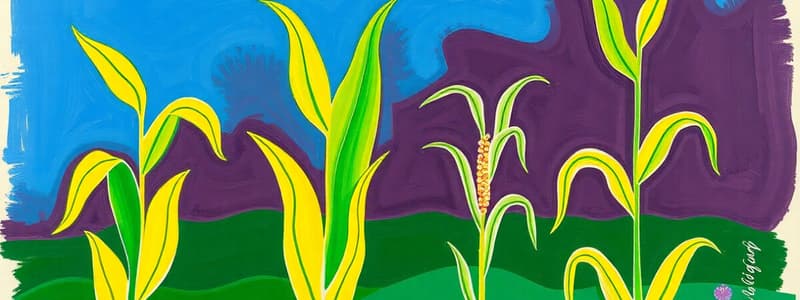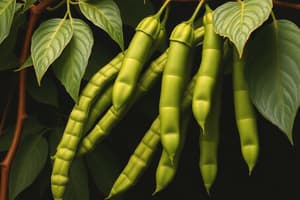Podcast
Questions and Answers
Which of these features characterises the vegetative growth stage in both bean and corn plants?
Which of these features characterises the vegetative growth stage in both bean and corn plants?
- Both plants start developing their root systems (correct)
- The plant's primary focus shifts to maximizing seed production
- The plants rely solely on stored nutrients for growth
- Development of flowers and fruits begins
How does the root system differ between bean and corn plants in the vegetative growth stage?
How does the root system differ between bean and corn plants in the vegetative growth stage?
- Both plants develop taproot systems
- Bean plants develop fibrous root systems, while corn plants develop taproot systems
- Corn plants develop fibrous root systems, while bean plants develop taproot systems (correct)
- Both plants develop fibrous root systems
What is the primary source of energy for both bean and corn plants during the vegetative growth stage?
What is the primary source of energy for both bean and corn plants during the vegetative growth stage?
- Fertilization of the female flowers
- Photosynthesis by the leaves (correct)
- Wind pollination of the flowers
- Stored nutrients from the seed
How does the flowering process differ between bean and corn plants?
How does the flowering process differ between bean and corn plants?
During the fruit formation and maturation stage, how do bean and corn plants differ with respect to their seeds?
During the fruit formation and maturation stage, how do bean and corn plants differ with respect to their seeds?
In which stage of germination are the cotyledons pushed above the soil?
In which stage of germination are the cotyledons pushed above the soil?
What is the purpose of the coleoptile in a corn plant?
What is the purpose of the coleoptile in a corn plant?
Which of the following conditions is NOT essential for seed germination?
Which of the following conditions is NOT essential for seed germination?
What is the term for the embryonic root of a plant?
What is the term for the embryonic root of a plant?
Which type of plant completes its life cycle in one growing season?
Which type of plant completes its life cycle in one growing season?
What is the primary food source for a bean seedling during the seedling growth stage?
What is the primary food source for a bean seedling during the seedling growth stage?
Which of the following is a reason why growth may slow down or stop after a certain time?
Which of the following is a reason why growth may slow down or stop after a certain time?
Which of the following statements is TRUE about the growth patterns of annual plants?
Which of the following statements is TRUE about the growth patterns of annual plants?
Which part of the seed is responsible for providing food to the developing plant until it can photosynthesize?
Which part of the seed is responsible for providing food to the developing plant until it can photosynthesize?
What is the primary function of the radicle?
What is the primary function of the radicle?
Which of these seed dispersal methods involves sticky or hooked seeds?
Which of these seed dispersal methods involves sticky or hooked seeds?
What is the main purpose of seed dispersal?
What is the main purpose of seed dispersal?
Which condition is NOT required for seed germination?
Which condition is NOT required for seed germination?
What is the first stage of seed germination?
What is the first stage of seed germination?
Which of these statements accurately describes the trend in the bean plant's growth shown on the graph?
Which of these statements accurately describes the trend in the bean plant's growth shown on the graph?
Based on the trend in the growth of the bean plant, what would you predict its height to be at Week 8?
Based on the trend in the growth of the bean plant, what would you predict its height to be at Week 8?
What is the primary function of the petals in a flower?
What is the primary function of the petals in a flower?
Which of these is NOT a benefit of cross-pollination?
Which of these is NOT a benefit of cross-pollination?
Which part of the flower develops into the fruit?
Which part of the flower develops into the fruit?
What is the primary function of the cotyledons in a seed?
What is the primary function of the cotyledons in a seed?
Which of these is an example of a true fruit?
Which of these is an example of a true fruit?
What is the primary function of the pericarp?
What is the primary function of the pericarp?
What is the process called when pollen is transferred from the anther to the stigma of the same flower?
What is the process called when pollen is transferred from the anther to the stigma of the same flower?
What is the difference between a plumule and a radicle?
What is the difference between a plumule and a radicle?
Flashcards
Embryo
Embryo
The developing plant inside a seed, consisting of cotyledons and immature shoots.
Cotyledons
Cotyledons
Seed leaves that provide a food source for the embryo until true leaves appear.
Radicle
Radicle
The young root of a plant, emerging first from the seed to absorb water and nutrients.
Plumule
Plumule
Signup and view all the flashcards
Seed Dispersal
Seed Dispersal
Signup and view all the flashcards
Wind Dispersal
Wind Dispersal
Signup and view all the flashcards
Germination
Germination
Signup and view all the flashcards
Stages of Germination
Stages of Germination
Signup and view all the flashcards
Sexual reproduction in plants
Sexual reproduction in plants
Signup and view all the flashcards
Parts of a flower
Parts of a flower
Signup and view all the flashcards
Pollination
Pollination
Signup and view all the flashcards
Types of pollination
Types of pollination
Signup and view all the flashcards
Zygote development
Zygote development
Signup and view all the flashcards
Seed structure
Seed structure
Signup and view all the flashcards
Fruit formation
Fruit formation
Signup and view all the flashcards
True vs False fruits
True vs False fruits
Signup and view all the flashcards
Coleoptile
Coleoptile
Signup and view all the flashcards
Vegetative Growth Stage
Vegetative Growth Stage
Signup and view all the flashcards
Flowering Stage
Flowering Stage
Signup and view all the flashcards
Kernel Development
Kernel Development
Signup and view all the flashcards
Conditions for Germination
Conditions for Germination
Signup and view all the flashcards
Role of Water in Germination
Role of Water in Germination
Signup and view all the flashcards
Oxygen in Seed Growth
Oxygen in Seed Growth
Signup and view all the flashcards
Temperature Influence
Temperature Influence
Signup and view all the flashcards
Epigeal Germination
Epigeal Germination
Signup and view all the flashcards
Hypogeal Germination
Hypogeal Germination
Signup and view all the flashcards
Growth Stages of Plants
Growth Stages of Plants
Signup and view all the flashcards
Role of Cotyledons
Role of Cotyledons
Signup and view all the flashcards
Study Notes
Sexual Reproduction in Flowering Plants
- Sexual reproduction in plants involves the fusion of gametes, forming seeds and fruits.
- Flowers are the reproductive structures of plants.
- Flower parts include petals, sepals, stamen, and pistil (carpel).
- Petals attract pollinators; sepals protect the flower bud.
Pollination
- Pollination is the transfer of pollen from the anther to the stigma.
- Types include self-pollination (within the same flower) and cross-pollination (between different flowers).
- Cross-pollination increases genetic diversity and adaptation to changing environments.
- Agents of pollination include wind, water, insects, birds, and other small animals.
Wind-Pollinated Flowers
- Small, inconspicuous petals or no petals.
- No scent or nectar.
- Large quantities of light, dry pollen.
- Long filaments and large anthers for wind dispersal.
- Large, feathery stigmas to catch pollen.
Insect-Pollinated Flowers
- Large, brightly colored petals (to attract insects).
- Often scented and/or produce nectar to attract insects.
- Smaller quantities of rough or sticky pollen that adheres to insects.
- Stiff filaments and anthers inside the flower.
- Small, stiff, sticky stigmas to capture pollen from insects.
Fertilization
- After pollination, the male gamete reaches the female gamete for fertilization.
- A pollen grain lands on the stigma and develops a pollen tube.
- The tube grows, carrying the male gamete through the style to the ovary.
- The male gamete fuses with the female gamete to form a zygote.
- Each ovule develops into a seed.
- The ovary wall develops into the fruit.
- The fruit protects and helps disperse the seeds.
Seed Formation
- Zygote develops into an embryo.
- Ovule transforms into the seed, with a seed coat (testa).
- Embryo develops from a young shoot (plumule), radicle (root), and cotyledons (food stores).
- Parts of a seed include the embryo, cotyledons, and seed coat.
Fruit Formation
- Ovary develops into fruit, forming pericarp (fruit wall).
- Types of fruits include true fruits (develop from ovary only) and false fruits (develop from other flower parts).
- Functions of fruits include seed protection and dispersal.
Seed Dispersal
- Seeds must be spread from the parent plant.
- Methods include wind, water, and animal dispersal.
- Wind-dispersed seeds are light and have wings or feathery structures.
- Water-dispersed seeds float.
- Animal-dispersed seeds are in fleshy fruits or have hooks or barbs.
- Mechanical dispersal involves fruits that burst open.
Germination
- Germination needs water, oxygen, and suitable temperature for seeds to sprout.
- Water softens the seed coat and activates enzymes.
- Oxygen is needed for respiration.
- Suitable temperature activates enzymes.
Growth Patterns in Plants
- Three main conditions for seed germination are water, oxygen, and suitable temperature.
- Annual plants complete their life cycle in one season.
- Beans (dicots) and corn (monocots) have different growth patterns.
- Bean: epigeal germination (cotyledons above ground).
- Corn: hypogeal germination (cotyledons below ground).
- Stages of growth after germination include seedling, vegetative, flowering, and fruit formation.
Studying That Suits You
Use AI to generate personalized quizzes and flashcards to suit your learning preferences.




